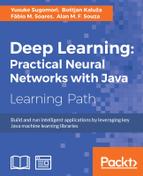 Summary
by Alan M. F. Souza, Fábio M. Soares, Boštjan Kaluža, Yusuke Sugomori
Deep Learning: Practical Neural Networks with Java
Summary
by Alan M. F. Souza, Fábio M. Soares, Boštjan Kaluža, Yusuke Sugomori
Deep Learning: Practical Neural Networks with Java
- Deep Learning: Practical Neural Networks with Java
- Table of Contents
- Deep Learning: Practical Neural Networks with Java
- Deep Learning: Practical Neural Networks with Java
- Credits
- Preface
- 1. Java Deep Learning Essentials
- 1. Deep Learning Overview
- 2. Algorithms for Machine Learning – Preparing for Deep Learning
- 3. Deep Belief Nets and Stacked Denoising Autoencoders
- 4. Dropout and Convolutional Neural Networks
- 5. Exploring Java Deep Learning Libraries – DL4J, ND4J, and More
- 6. Approaches to Practical Applications – Recurrent Neural Networks and More
- 7. Other Important Deep Learning Libraries
- 8. What's Next?
- 2. Machine Learning in Java
- 1. Applied Machine Learning Quick Start
- 2. Java Libraries and Platforms for Machine Learning
- 3. Basic Algorithms – Classification, Regression, and Clustering
- 4. Customer Relationship Prediction with Ensembles
- 5. Affinity Analysis
- 6. Recommendation Engine with Apache Mahout
- 7. Fraud and Anomaly Detection
- 8. Image Recognition with Deeplearning4j
- 9. Activity Recognition with Mobile Phone Sensors
- 10. Text Mining with Mallet – Topic Modeling and Spam Detection
- 11. What is Next?
- A. References
- 3. Neural Network Programming with Java, Second Edition
- 1. Getting Started with Neural Networks
- Discovering neural networks
- Why artificial neural networks?
- How neural networks are arranged
- The very basic element – artificial neuron
- Giving life to neurons – activation function
- The flexible values – weights
- An extra parameter – bias
- The parts forming the whole – layers
- Learning about neural network architectures
- Monolayer networks
- Multilayer networks
- Feedforward networks
- Feedback networks
- From ignorance to knowledge – learning process
- Let the coding begin! Neural networks in practice
- The neuron class
- The NeuralLayer class
- The ActivationFunction interface
- The neural network class
- Time to play!
- Summary
- 2. Getting Neural Networks to Learn
- 3. Perceptrons and Supervised Learning
- 4. Self-Organizing Maps
- Neural networks unsupervised learning
- Unsupervised learning algorithms
- Kohonen self-organizing maps
- Extending the neural network code to Kohonen
- Zero-dimensional SOM
- One-dimensional SOM
- Two-dimensional SOM
- 2D competitive layer
- SOM learning algorithm
- Effect of neighboring neurons – the neighborhood function
- The learning rate
- A new class for competitive learning
- Visualizing the SOMs
- Plotting 2D training datasets and neuron weights
- Testing Kohonen learning
- Summary
- 5. Forecasting Weather
- Neural networks for regression problems
- Loading/selecting data
- Choosing input and output variables
- Preprocessing
- Normalization
- Adapting NeuralDataSet to handle normalization
- Adapting the learning algorithm to normalization
- Java implementation of weather forecasting
- Collecting weather data
- Delaying variables
- Loading the data and beginning to play!
- Let's perform a correlation analysis
- Creating neural networks
- Training and test
- Viewing the neural network output
- Empirical design of neural networks
- Summary
- 6. Classifying Disease Diagnosis
- 7. Clustering Customer Profiles
- 8. Text Recognition
- 9. Optimizing and Adapting Neural Networks
- 10. Current Trends in Neural Networks
- A. References
- Chapter 1: Getting Started with Neural Networks
- Chapter 2: Getting Neural Networks to Learn
- Chapter 3: Perceptrons and Supervised Learning
- Chapter 4: Self-Organizing Maps
- Chapter 5: Forecasting Weather
- Chapter 6: Classifying Disease Diagnosis
- Chapter 7: Clustering Customer Profiles
- Chapter 8: Text Recognition
- Chapter 9: Optimizing and Adapting Neural Networks
- Chapter 10: Current Trends in Neural Networks
- Bibliography
- 1. Getting Started with Neural Networks
- Index
In this chapter, you learned how to implement deep learning models with the libraries ND4J and DL4J. Both support GPU computing and both give us the ability to implement them without any difficulties. ND4J is a library for scientific computing and enables vectorization, which makes it easier to implement a calculation among arrays because we don't need to write iterations within them. Since machine learning and deep learning algorithms have many equations with vector calculations, such as inner products and element-wise multiplication, ND4J also helps implement them.
DL4J is a library for deep learning, and by following some examples with the library, you saw that we can easily build, train, and evaluate various types of deep learning models. Additionally, while building the model, you learned why regularization is necessary to get better results. You also got to know some optimizers of the learning rate: momentum, ADAGRAD, and ADADELTA. All of these can be implemented easily with DL4J.
You gained knowledge of the core theories and implementations of deep learning algorithms and you now know how to implement them with little difficulty. We can say that we've completed the theoretical part of this book. Therefore, in the next chapter, we'll look at how deep learning algorithms are adapted to practical applications first and then look into other possible fields and ideas to apply the algorithms.
-
No Comment